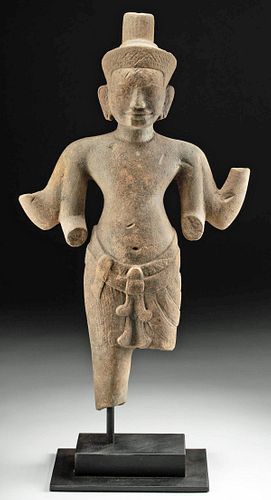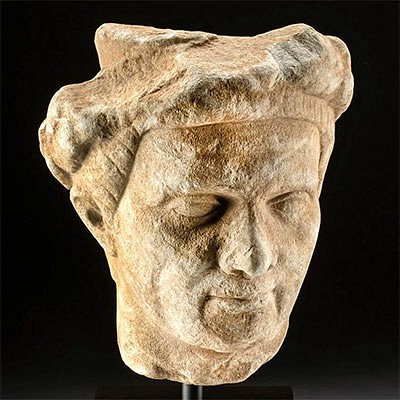12th C. Cambodian Khmer Stone Figure of a Deity
Lot 99
About Seller
Artemis Fine Arts
686 S Taylor Ave, Ste 106
Louisville, CO 80027
United States
Selling antiquities, ancient and ethnographic art online since 1993, Artemis Gallery specializes in Classical Antiquities (Egyptian, Greek, Roman, Near Eastern), Asian, Pre-Columbian, African / Tribal / Oceanographic art. Our extensive inventory includes pottery, stone, metal, wood, glass and textil...Read more
Categories
Estimate:
$13,000 - $19,500
Absentee vs Live bid
Two ways to bid:
- Leave a max absentee bid and the platform will bid on your behalf up to your maximum bid during the live auction.
- Bid live during the auction and your bids will be submitted real-time to the auctioneer.
Bid Increments
| Price | Bid Increment |
|---|---|
| $0 | $25 |
| $300 | $50 |
| $1,000 | $100 |
| $2,000 | $250 |
| $5,000 | $500 |
| $10,000 | $1,000 |
| $20,000 | $2,500 |
| $50,000 | $5,000 |
| $100,000 | $10,000 |
| $200,000 | $20,000 |
About Auction
By Artemis Fine Arts
Jun 1, 2023
Set Reminder
2023-06-01 10:00:00
2023-06-01 10:00:00
America/New_York
Bidsquare
Bidsquare : Ancient | Asian | Ethno | Native American Art
https://www.bidsquare.com/auctions/artemis-gallery/ancient-asian-ethno-native-american-art-12905
Featuring classical antiquities, ancient, and ethnographic art from cultures encompassing the globe. Egyptian, Greek, Roman, Near Eastern, Asian, Pre-Columbian, Native American, African / Tribal, Oceanic, Spanish Colonial, Fossils, more! All legally acquired, legal to sell. Satisfaction guaranteed. Artemis Fine Arts info@artemisfinearts.com
Featuring classical antiquities, ancient, and ethnographic art from cultures encompassing the globe. Egyptian, Greek, Roman, Near Eastern, Asian, Pre-Columbian, Native American, African / Tribal, Oceanic, Spanish Colonial, Fossils, more! All legally acquired, legal to sell. Satisfaction guaranteed. Artemis Fine Arts info@artemisfinearts.com
- Lot Description
Southeast Asia, Cambodia, Khmer Empire, Angkor Wat style, ca. 12th century CE. An exceptional sandstone sculpture of a deity depicted with 4 outspread arms, bent at the elbows, and bare-chested with a sampot loosely secured by a belt at his hips. His tranquil visage is comprised of elongated eyes, a petite nose, and a sizable mouth, all crowned by an elaborate tiara atop matted hair pulled into a columnar top bun. Elongated ears flank his face symbolizing his spirituality, while distinctive pleated "double anchor" or "fishtail" pendants fall down the front of his sampot. His hourglass form is quite androgynous, featuring broad shoulders, a corseted waist and wide hips. The sturdiness of his leg indicates he was once a freestanding sculpture that did not need additional support. Size: 14.9" W x 25.3" H (37.8 cm x 64.3 cm); 29.3" H (74.4 cm) on included custom stand.
The identity of this deity is quite the mystery. Buddhism and Hinduism were the 2 most popular religions in the Khmer Empire with Hinduism initially revered as the main state religion and Buddhism following after. Thus, figures that were created for one religion were sometimes repurposed for the other. For example, a sandstone figure of 4-armed Shiva at the Asia Society (1979.064) features deliberate abrasions in the center of its headdress suggesting that it was once a Buddhist representation of a Avalokiteshvara, the Bodhisattva of Compassion, who typically is shown with a seated Amitabha Buddha on his crown. The 4 arms and headdress of this example indicates that he may have represented either Vishnu or Shiva - the 2 most venerated deities in Khmer Hindu temples. However, the absence of a third eye on the forehead and loss of the hands leaves open the possibility of him being a Bodhisattva of Buddhism.
Khmer art shifted away from Indian styles in the 7th century CE to encompass its own framework; one example of this seen here is that this statue is carved in the round, rather than as a relief on a stela, which was common with Indian and Javanese Hindu and Buddhist sculptures that previously influenced Cambodian art. From this, we can infer that Khmer sculptors would have desired their artwork to be viewed from all sides, and thus placed in the center of temples rather than against a wall. While this artwork was religious - priests supervised its execution - its realism is unmistakable, and some scholars believe that gods and goddesses were portrayed with the features of individual members of the royal court. This sculpture and others like it would have both emphasized the power of the monarchy and given high ranking people joy - after all, who wouldn't want to see themselves sculpted by the finest artisans in stone and compared to a god?
Cf. the Walters Art Museum (25.229).
PLEASE NOTE: Due to recent increases of shipments being seized by Australian & German customs (even for items with pre-UNESCO provenance), we will no longer ship most antiquities and ancient Chinese art to Australia & Germany. For categories of items that are acceptable to ship to Australia or Germany, please contact us directly or work with your local customs brokerage firm.
This item is heavy/oversized and will require 3rd party shipping. Please inquire about shipping cost prior to bidding.
Provenance: private Hawaii collection, acquired 2000 to 2010
All items legal to buy/sell under U.S. Statute covering cultural patrimony Code 2600, CHAPTER 14, and are guaranteed to be as described or your money back.
A Certificate of Authenticity will accompany all winning bids.
We ship worldwide and handle all shipping in-house for your convenience.
#177485Missing forearms, left leg, and right lower leg, as well as stable hairline fissures to shoulders and losses to earlobes. Expected nicks and abrasions to surface with a few small chips in areas. Otherwise, in good condition with smooth surfaces and nice remaining detail. Earthen deposits in areas.Condition
- Shipping Info
-
All shipping is handled in-house for your convenience. Your invoice from Artemis Gallery will include shipping calculation instructions. If in doubt, please inquire BEFORE bidding for estimated shipping costs for individual items.
-
- Buyer's Premium



 EUR
EUR CAD
CAD AUD
AUD GBP
GBP MXN
MXN HKD
HKD CNY
CNY MYR
MYR SEK
SEK SGD
SGD CHF
CHF THB
THB














